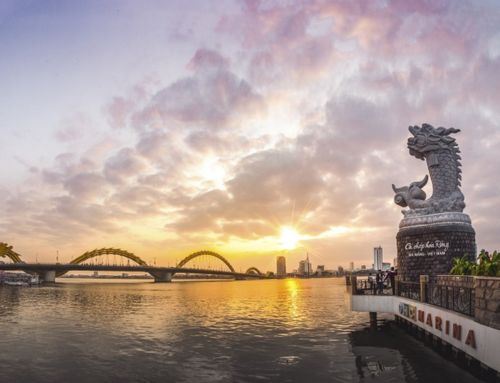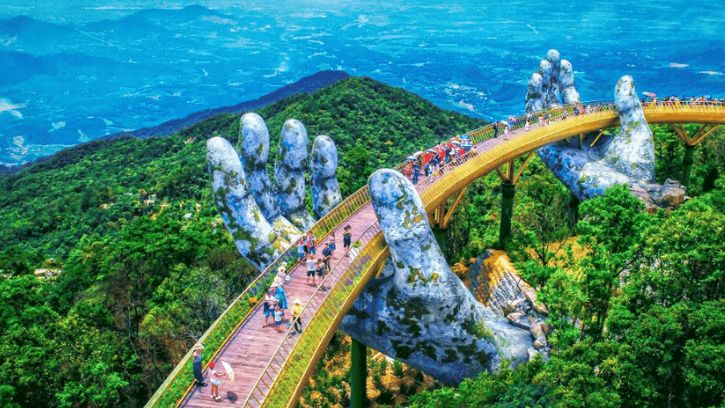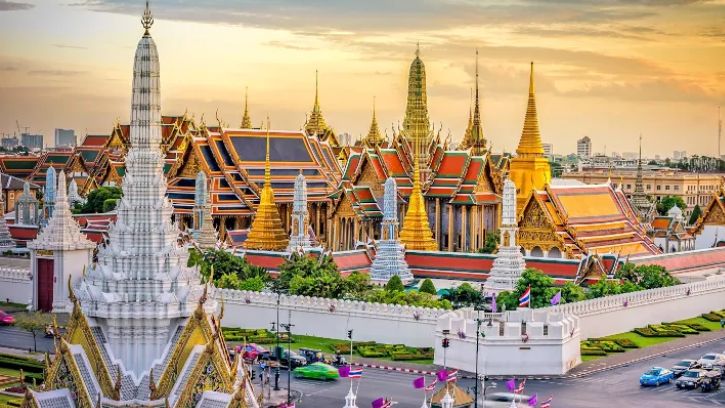

BEST TIME TO VISIT VIETNAM:
Weather in Vietnam
Before delving into the specifics, let’s take a look at the overall weather patterns in Vietnam. The country experiences a tropical monsoon climate, characterized by high humidity and distinct wet and dry seasons. The weather varies significantly between the north and the south of Vietnam, so it’s essential to plan accordingly.
Seasons in Vietnam
Vietnam has four distinct seasons: spring, summer, autumn, and winter. Each season has its unique characteristics, offering travelers different experiences and activities.
Best time to visit Vietnam: Spring (March to May)
Spring is considered one of the best times to visit Vietnam. The weather is mild, with temperatures ranging from 20°C to 30°C (68°F to 86°F). The countryside bursts into life with colorful flowers, and rice terraces are lush green. This is an excellent time to explore the northern regions, such as Hanoi, Sapa, and Halong Bay.
Best time to visit Vietnam: Summer (June to August)
Summer in Vietnam brings high temperatures and humidity, especially in the central and southern parts of the country. The average temperatures range from 30°C to 35°C (86°F to 95°F), making it an ideal time for beach lovers to visit popular coastal destinations like Nha Trang and Phu Quoc. However, it’s worth noting that summer is also the rainy season, so be prepared for occasional downpours.
Best time to visit Vietnam: Autumn (September to November)
Autumn is another fantastic season to visit Vietnam, particularly in September and October. The weather becomes cooler and more pleasant, with temperatures ranging from 20°C to 30°C (68°F to 86°F). This is a great time to explore cities like Hanoi and Hue or embark on a trekking adventure in the mountainous regions of Sapa or Dalat.
Best time to visit Vietnam: Winter (December to February)
Winter in Vietnam brings cooler temperatures, especially in the north, where it can drop to around 10°C (50°F). However, the southern part of the country remains warm and comfortable. This is a suitable time to visit Ho Chi Minh City, the Mekong Delta, and other southern destinations. It’s also an excellent time to experience the festive atmosphere during the Vietnamese New Year, known as Tet.
Best time to visit Vietnam: Northern Vietnam
Northern Vietnam offers a fascinating mix of vibrant cities, breathtaking landscapes, and cultural treasures. The best time to visit Vietnam in this region is during spring (March to May) and autumn (September to November) when the weather is mild and pleasant. Hanoi, the capital city, is a must-visit destination, where you can explore ancient temples, taste delicious street food, and witness the hustle and bustle of the Old Quarter. Other highlights include Halong Bay, Sapa, and Ninh Binh.Central Vietnam is known for its stunning coastal cities, UNESCO World Heritage sites, and mouthwatering cuisine. The best time to visit this region is during spring (March to May) and autumn (September to November) when the weather is pleasant and rainfall is minimal.One of the most popular destinations in Central Vietnam is Hoi An, a charming town renowned for its well-preserved ancient architecture and lantern-lit streets. Stroll along the Thu Bon River, immerse yourself in the vibrant local markets, and indulge in delicious local dishes. Hoi An is especially captivating during the full moon lantern festival, where the town comes alive with colorful lanterns and traditional performances.Another gem in Central Vietnam is Hue, the former imperial capital. Explore the imposing citadel, visit the royal tombs, and take a boat ride along the Perfume River. Hue’s rich history and cultural heritage will transport you back in time.If you’re a nature enthusiast, don’t miss out on the stunning landscapes of Da Nang and the nearby Marble Mountains. Enjoy breathtaking views from the famous Golden Bridge and relax on the pristine beaches of My Khe.
Southern Vietnam
Moving further south, you’ll discover the vibrant and bustling cities of Southern Vietnam. Ho Chi Minh City, formerly known as Saigon, is a dynamic metropolis that perfectly blends tradition and modernity. Explore the historic landmarks like the Reunification Palace and the War Remnants Museum, indulge in the delicious street food, and experience the energetic nightlife of this cosmopolitan city. From Ho Chi Minh City, you can venture into the Mekong Delta, a maze of rivers, lush green fields, and floating markets. Take a boat ride along the waterways, visit local villages, and savor the flavors of the region’s fresh fruits and seafood.For beach lovers, the coastal town of Nha Trang is a paradise. With its crystal-clear waters and pristine sandy beaches, it’s an ideal spot for swimming, snorkeling, and diving. Explore the nearby islands, enjoy water sports activities, or simply bask in the sun.
Festivals and Events
Vietnam is known for its vibrant festivals and events throughout the year. One of the most significant celebrations is Tet, the Vietnamese New Year, which usually falls in late January or early February. Experience the lively atmosphere, join in the traditional customs, and enjoy firework displays and dragon dances.Another unique festival is the Mid-Autumn Festival, celebrated on the 15th day of the eighth lunar month. Children carry colorful lanterns, and families gather to enjoy mooncakes and perform traditional dances. It’s a delightful time to witness Vietnamese culture and traditions.
Popular Tourist Destinations
Apart from the specific regions mentioned earlier, Vietnam boasts many other popular tourist destinations. Ha Giang, in the far north, offers breathtaking landscapes with its towering mountains and winding roads. Explore the Dong Van Karst Plateau Geopark, interact with ethnic minority communities, and take in the awe-inspiring scenery.In the south, Phu Quoc Island is a tropical paradise known for its palm-fringed beaches, clear waters, and vibrant coral reefs. Relax on the white sandy beaches, snorkel in the azure waters, and indulge in fresh seafood.
Tips for Traveling
For the best time to visit Vietnam.Here are some essential tips to make your trip to Vietnam even more enjoyable:
- Pack Accordingly: Depending on the time of year and the regions you’re visiting, pack clothing suitable for both hot and humid weather and cooler temperatures in the north.
- Stay Hydrated: The weather can be quite humid, so remember to drink plenty of water and stay hydrated throughout the day.
- Try Local Cuisine: Vietnamese cuisine is renowned worldwide for its fresh ingredients and unique flavors. Don’t miss the chance to indulge in pho, banh mi, spring rolls, and other delicious dishes. Explore local street food stalls for an authentic culinary experience.
- Be Mindful of Cultural Etiquette: Vietnamese people are generally polite and respectful, and it’s important to reciprocate. Remember to dress modestly when visiting religious sites, take off your shoes when entering someone’s home, and use both hands when giving or receiving items.
- Bargaining Skills: Bargaining is common in local markets and small shops. Brush up on your bargaining skills to get a fair price for souvenirs and goods. Remember to negotiate with a smile and in a friendly manner.
- Stay Safe on the Roads: Traffic in Vietnam can be chaotic, especially in big cities. Exercise caution when crossing the streets and consider using transportation apps or hiring reputable drivers for longer journeys.
- Observe Visa Requirements: Ensure you have the necessary visa before entering Vietnam. Check with the Vietnamese embassy or consulate in your country to understand the requirements and apply in advance if needed.
- Stay Aware of Scams: Like any popular tourist destination, scams can happen. Be cautious of overly friendly strangers offering unsolicited help and always double-check prices before making any purchases or booking tours.
- Get Travel Insurance: It’s always a good idea to have travel insurance that covers medical emergencies, trip cancellations, and lost or stolen belongings. This will provide peace of mind during your journey.
- Learn Some Basic Vietnamese Phrases: While many Vietnamese people speak English, knowing a few basic phrases such as “hello,” “thank you,” and “excuse me” can go a long way in creating connections and showing respect to the locals.
FAQs (Frequently Asked Questions)
1. Is Vietnam safe for tourists? Yes, Vietnam is generally a safe country for tourists. However, it’s always advisable to take necessary precautions, such as being aware of your surroundings and belongings, using reputable transportation services, and following local guidelines.
2. What is the currency in Vietnam? The currency in Vietnam is the Vietnamese Dong (VND). It’s recommended to have some local currency on hand for small purchases, but credit cards are widely accepted in most hotels, restaurants, and shops.
3. Can I drink tap water in Vietnam? It’s generally not recommended to drink tap water in Vietnam. Stick to bottled water, which is readily available and affordable. Also, avoid consuming ice cubes from unknown sources.
4. What is the best way to get around Vietnam? Vietnam has a well-connected transportation network. Domestic flights are convenient for covering long distances, while trains, buses, and taxis are popular for shorter journeys within cities or between neighboring towns.
5. Are there any specific customs or etiquette I should be aware of? Vietnamese culture places importance on respect and modesty. Dress modestly when visiting religious sites, remove your shoes when entering someone’s home, and be mindful of local customs and traditions. Showing respect to elders and addressing people with their appropriate titles is also appreciated.
Remember to always check the latest travel advisories and guidelines before planning your trip to Vietnam.


